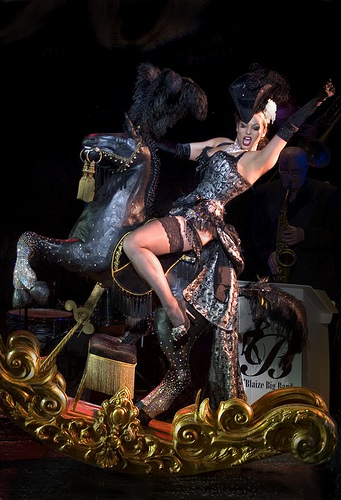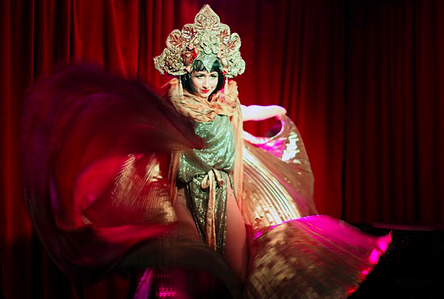
Elsie Diamond (photographed by Ksenia Maqa) performs ‘Dubstep Turandot’ in an extravagant oriental-inspired costume.
“Is not the most erotic portion of the body where the garment gapes?… There are no erogenous zones; it is intermittence which is erotic: the intermittence of skin flashing between two articles of clothing… between two edges…; it is this flash itself which seduces, or rather: the staging of an appearance-as-disappearance” – Roland Barthes [1]
In a previous post I mentioned Roland Barthes’ suggestion that an illicit glimpse of flesh can be more enticing than nudity. In fashion and costume, garments have always been notable for what they expose rather than cover (see, for example, the controversy caused by decreasing skirt length in the first half of the twentieth century). In such cases, fabric is notable in its absence, often more than its presence (which is taken for granted).
In the twenty-first century we are so jaded to the sight of near-naked bodies that they seem unremarkable. It is not uncommon to see legs, stomachs and cleavages on show. This contemporary fashion environment has yielded jeggings and super-low necklines that leave little to the imagination. Bare skin on display has become unremarkable, and has lost its power to shock or entice. As a result, Barthes’ words were never more true. The legs on display under a miniskirt are far less enticing than the fleeting glimpse of thigh that appears intermittently through the side-split of a much longer skirt; a cleavage that is barely visible through a layer of organza is more likely to attract the eye than breasts on show in a low-cut top.
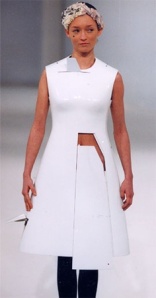
Hussein Chalayan’s remote control ‘airplane’ dress (S/S 2000) is constructed of sliding panels which slide to reveal glimpses of skin.
These values are reflected in high-fashion. Hussein Chalayan’s Remote Control Dress (Spring/Summer 2000) is moulded from fibreglass and resin panels which are controlled remotely, and slide in and out to reveal parts of the body. The dress reveals small areas of skin, providing viewers with a brief glimpse of the body. The glimpse is coy and fleeting, creating a sense that it is forbidden. This is, in Barthes words, “the staging of an appearance-as-disappearance”.

Eliza DeLite, who recently put a show on hold for costume restoration. Her costumes create such spectacle that they can even detract attention from the dancer’s partial nudity.
The most appropriate context for this debate is the world of burlesque. Burlesque, which is sometimes thought synonymous with stripping, is arguably more about keeping clothes on than taking them off. The costume transforms the act into an opulent spectacle. Dancers are celebrated for having unique and elaborate costumes. They establish the tone and theme of the act, and are essential in defining a dancer’s performance. The costume establishes the identity that the dancer has chosen for a particular act, and the show is choreographed to suit the component parts of a very particular costume. So entwined are the costume and the act, that it would be impossible to perform a burlesque dance in a substitute costume without making modifications to the routine. The costume is so vital that Eliza DeLite recently put her Strip ‘n’ Shimmy act on hold for costume restoration [2]. Every movement is choreographed around a particular garment or accessory. To a great extent, the costume dictates the moves.
In describing her debut, Dita Von Teese contrasts her performance with those of strippers by detailing her costume. She wore “a proper crinoline dress over a tightlaced corset with seamed stockings, garters, and long black opera gloves” and later “left the club a lady – in hat [and] gloves” [3]. In a strip-club, the acts are all about flesh: strippers arrive onstage already scantily clad, and their stripping is only a prelude to nudity. The core of the show is performed either mostly or completely nude. In contrast, burlesque dancers sustain the striptease until the very last moment of the show. The nudity is the finale.
Burlesque performance celebrates progression towards nudity, rather than nudity itself. The longer the dancer can sustain the tease, the more erotic the performance will be. It is in the dancer’s interest to keep the clothes on for as long as possible: to remove the costume a small piece at a time, and at an almost languid pace. The dancer, and the audience, know that once she is naked, the show is over. There is nothing left to discover.
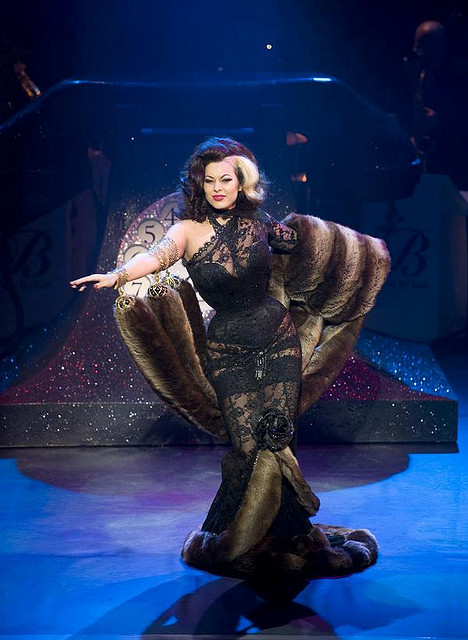
Immodesty Blaise on stage wearing 3 fur stoles, a fur skirt-cuff, a lace dress, and corset. Each of these items can be removed separately, prolonging the progress towards nudity.
The burlesque costume is designed to slow the progress towards nudity. It contains many more garments and accessories than an everyday wardrobe, and dresses are often composed of several parts that can be detached and removed separately. Costumes can consist of numerous layers, beginning with an overcoat or cape, then a dress of several parts, and even when that is removed there are usually three or four layers of lingerie underneath, each layer of which is progressively smaller and more revealing. The greater the number of pieces, the longer it will take to remove the costume, and hence the more provocative the act will be. As each small part is removed, only minor progress is made towards revealing the body.
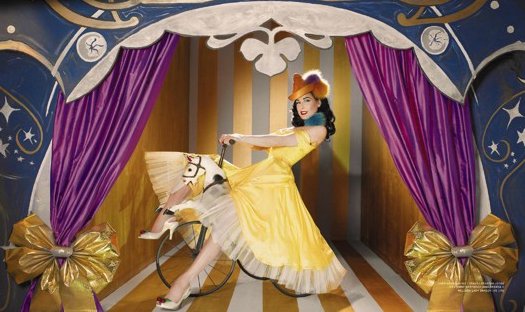
Dita Von Teese. In the right pose, costume and context, even just a glimpse of ankles can be erotic.
The eroticism of the striptease may be, in part, nostalgic. Nostalgia is at the core of many burlesque acts. Burlesque celebrates the 1940s pin-up and 1920s Hollywood glamour. The costumes tend to include vintage or historical references, not least with corsets. But more than this, it celebrates a time when bare flesh was not so ubiquitous. In that context, a flash of ankle or a glimpse of shoulder is worthy of celebration.
See the Pinterest gallery which accompanies this article: http://pinterest.com/costumeand/burlesque/
References:
[1] Roland Barthes, ‘Where the Garment Gapes’, extract from Pleasure of the Text, 1975, reproduced in ed. Malcolm Barnard, Fashion Theory: A Reader, London: Routledge, 2007, p. 601.
[2] Eliza Delite, http://eliza-delite.wix.com/burlesque#!acts/vstc4=article-2
[3] Dita Von Teese, Burlesque and the Art of the Tease, New York: Harper Collins, 2006, p. 20.

